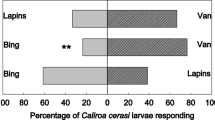Abstract
Effects of malic acid and oxalic acid on oviposition of Helicoverpa armigera were investigated in a laboratory cage choice experiment. Malic acid stimulated oviposition at a concentration of 0.6 μmol/cm2 but inhibited it at 3.4 μmol/cm2. Oxalic acid showed neither stimulation nor inhibition of oviposition at 0.25–1.7 μmol/cm2. Correlations between the amount of these acids in trichome exudate on leaf and pod surface and H. armigera populations and pod damage were investigated in a field experiment using 14 chickpea genotypes. Malic acid on the leaves stimulated oviposition during the vegetative and flowering stages, when its concentration was 0.1–0.7 μmol/cm2. Later, during the podding stage there was no significant correlation between either egg density or pod damage and malic acid levels. However, there was a significant negative correlation between pod damage and oxalic acid levels. Oxalic acid, which had been reported to have an antibiotic effect on H. armigera larvae, has an important role in resistance to this pest in chickpea. The length of the podding period was also a factor influencing the extent of pod damage; a longer podding period resulted in prolonged exposure to H. armigera attack and more pod damage.
Similar content being viewed by others
REFERENCES
ARMES, N. J., BOND, G. S., and COOTER, R. J. 1992a. The laboratory culture and development of Helicoverpa armigera. Natural Resources Institute Bulletin 57. Natural Resources Institute, Chatham, United Kingdom, pp. 20–21.
ARMES, N. J., JADHAV, D. R., BOND, G. S., and KING, A. B. S. 1992b. Insecticide resistance in Helicoverpa armigera in south India. Pestic. Sci. 34:355–364.
ARMES, N. J., JADHAV, D. R., and LONERGAN, P. A. 1994. Insecticide resistance in Helicoverpa armigera: Status and prospects for its management in India, pp. 522–533, in Proceedings of World Cotton Research Conference-1, February 13–17, 1994. Brisbane, Australia.
COWGILL, S. E., and LATEEF, S. S. 1996. Identification of antibiotic and antixenotic resistance to Helicoverpa armigera (Lepidoptera: Noctuidae) in chickpea. J. Econ. Entomol. 89:224–229.
DIAS, C. A. R., LAL, S. S., and YADAVA, C. P. 1983. Differences in susceptibility of certain chickpea cultivars and local collections to Heliothis armigera (Hubner). Indian J. Agric. Sci. 53:842–845.
FAO, 1994. FAO Yearbook, Production. Vol. 47. FAO, Rome, Italy, 104 pp.
FITT, G. P. 1989. The ecology of Heliothis species in relation to agroecosystems. Annu. Rev. Entomol. 34:17–52.
LAL, S. S., YADAVA, C. P., and SACHAN, J. N. 1986. Strategies for the development of an integrated approach to control gram pod borer, Heliothis armigera (Hubner) infesting chickpea. Pesticides May:39–51.
LATEEF, S. S. 1985. Gram pod borer (Heliothis armigera) (Hub.) resistance in chickpeas. Agric. Ecosyst. Environ. 14:95–102.
LATEEF, S. S., and SACHAN, J. N. 1990. Host-plant resistance of Helicoverpa armigera in different agroecological contexts, pp. 181–189, in Chickpea in the Nineties: Proceedings of the Second International Workshop on Chickpea Improvement, December 4–8, 1989, ICRISAT Center, India. ICRISAT, Patancheru, Andhra Pradesh, India.
REED, W., CARDONA, C., SITHANANTHAM, S., and LATEEF, S. S. 1987. Chickpea insect pests and their control, pp. 283–318, in M. C. Saxena and K. B. Singh (eds.). The Chickpea. CAB International, Oxon, UK.
REMBOLD, H. 1981. Malic acid in chickpea exudate—a marker for Heliothis resistance. Int. Chickpea Newsl. 4:18–19.
REMBOLD, H., and WEIGNER, CH. 1990. Chemical composition of chickpea, Cicer arietinum, exudate. Z. Naturforsch. 45c:922–923.
REMBOLD, H., and WINTER, E. 1982. The chemist's role in host-plant resistance studies, pp. 241–250, in Proceedings of the International Workshop on Heliothis Management, November 15–20, 1981, ICRISAT Center, India. ICRISAT, Patancheru, Andhra Pradesh, India.
REMBOLD, H., SCHROTH, A., LATEEF, S. S., and WEIGNER, CH. 1990a. Semiochemical and host-plant selection by Helicoverpa armigera: Basic studies in the laboratory for the field, pp. 23–26, in Summary proceedings of the First Consultative Group Meeting on the Host Selection Behavior of Helicoverpa armigera, March 5–7, 1990, ICRISAT Center, India. ICRISAT, Patancheru, Andhra Pradesh, India.
REMBOLD, H., WALLNER, P., KÖHNE, A., LATEEF, S. S., GRUNE, M., and WEIGNER, CH. 1990b. Mechanisms of host-plant resistance with special emphasis on biochemical factors, pp. 191–194, in Chickpea in the Nineties: Proceedings of the Second International Workshop on Chickpea Improvement, December 4–8, 1989, ICRISAT Center, India. ICRISAT, Patancheru, Andhra Pradesh, India.
SRIVASTAVA, C. P., and SRIVASTAVA, R. P. 1989. Screening for resistance to gram pod borer, Heliothis armigera (Hubner), in chickpea (Cicer arietinum L.) genotypes and observation on its mechanism of resistance in India. Insect Sci. Applic. 10:225–258.
SRIVASTAVA, C. P., and SRIVASTAVA, R. P. 1990. Antibiosis in chickpea (Cicer arietinum L.) to gram pod borer, Heliothis armigera (Hubner) (Noctuidae: Lepidoptera) in India. Entomon 15:89–93.
WIGHTMAN, J. A., ANDERS, M. M., RAMESHWAR RAO, V., and MOHAN REDDY, L. 1995. Management of Helicoverpa armigera (Lepidoptera: Noctuidae) on chickpea in southern India: Thresholds and the economics of host plant resistance and insecticide application. Crop Prot. 14:37–46.
WILKINSON, L. 1990. SYSTAT: The system for statistics. SYSTAT Inc., Evanston, Illinois.
YOSHIDA, M., COWGILL, S. E., and WIGHTMAN, J. A. 1995. Mechanism of resistance to Helicoverpa armigera (Lepidoptera: Noctuidae) in chickpea: The role of oxalic acid in leaf exudate as an antibiotic factor. J. Econ. Entomol. 88:1783–1786.
Author information
Authors and Affiliations
Rights and permissions
About this article
Cite this article
Yoshida, M., Cowgill, S.E. & Wightman, J.A. Roles of Oxalic and Malic Acids in Chickpea Trichome Exudate in Host-Plant Resistance to Helicoverpa armigera . J Chem Ecol 23, 1195–1210 (1997). https://doi.org/10.1023/B:JOEC.0000006395.45516.e8
Issue Date:
DOI: https://doi.org/10.1023/B:JOEC.0000006395.45516.e8




